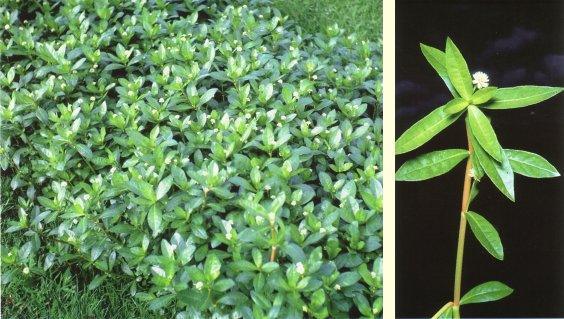|
 An
Illustrated Guide to An
Illustrated Guide to
Common Weeds
of New Zealand
Alternanthera
philoxeroides
alligator
weed
Family
AMARANTHACEAE
Reproduced from
Common
Weeds of New Zealand
by Ian Popay, Paul Champion & Trevor James
ISBN 0 473 09760 5
by kind permission of the
New
Zealand Plant Protection Society
Publication or other use of images or descriptive
text on these pages is unauthorised unless written permission is
obtained from the authors and publisher.
Appropriate acknowledgement
of the publication Common Weeds of New Zealand must always
be given.
Available from Nationwide Book Distributors
Aquatic perennial,
forming dense floating mats on fresh or brackish water, and also
creeping onto wet dune hollows and cropping land near waterways.
Soft, hollow stems up to 2 m long. Opposite leaves 5-10 cm long.
White flowers similar to white clover, but smaller.
- Flowers White,
small papery florets in six- to twenty-flowered, clover-like heads
up to 13 mm in diameter. Flower heads solitary on stalks up to
9 cm long in leaf axils, or on short stalks at the ends of the
branches. Flowers Dec-Feb.
- Fruit Not
produced in NZ and reproduction is only from stem fragments.
- Leaves Waxy,
elliptical to egg-shaped, 5-10 cm long, margins entire, in opposite
pairs, stalkless or with a short leaf stalk. A ring of white hairs
is found between the bases of the opposite leaves.
- Stems Thick,
soft, hollow, grooved, reddish, branching, to 10 m or more long,
floating or creeping. Stem tips upright, as much as 1 m above
the water.
- Roots Fibrous,
stems root from lower nodes.
Habitat
Warm, shallow, enriched,
fresh to slightly brackish water of drains, swamps, ponds, lagoons,
stream banks, dune hollows.
Distribution
NI only. Abundant in
North Auckland waterways especially around Kaipara Harbour, Auckland
City, Waikato River mouth and one or two sites in Waikato and
Bay of Plenty. Originally from Brazil.
Comments
Likely to spread further
south as a serious weed of waterways and of nearby crops. Insects
introduced as biological control agents give good control in lakes,
but not on wet land. Listed on the National
Pest Plant Accord (see Introduction for details).
Related
species
Nahui (Alternanthera
sessilis), native to NZ, is much smaller, with stalkless
axillary flower heads, occurring in damp open places, rarely in
dry waste areas and gardens, locally throughout NI, and in the
Lake Forsyth area in Canterbury.
Derivation
of botanical name
Alternanthera (Lat.)
= alternate anthers (the anthers are alternatively fertile and
sterile); philoxeroides (derivation unknown).
Web-notes:
Weed Links
On this site
Reproduced from Common Weeds
of New Zealand:
External Links
 Weedbusters
New Zealand Weedbusters
New Zealand
- Weedbusters is a weeds awareness and education programme that aims to
protect New Zealand's environment from the increasing weed problem.
- AgPest
- A free tool to assist farmers and agricultural professionals in decision-making regarding weed and pest identification, biology, impact and management.
 New Zealand Weeds Key New Zealand Weeds Key
- An interactive identification key to the weeds of New Zealand. Developed at Landcare Research.
New
Zealand Plant Conservation Network naturalised plants
- Search for information on more than 2500 naturalised and weedy plants.
 New
Zealand Plant Protection Society New
Zealand Plant Protection Society
- Their main objective: "To pool and exchange information on the biology
of weeds, invertebrate and vertebrate pests, pathogens and beneficial organisms
and methods for modifying their effects."
-
 Massey
University Weeds Database Massey
University Weeds Database- A site providing information about New Zealand weeds and weed control.
It has a series of pages showing pictures of New Zealand weeds, notes on
identification and control. It also provides information on a university
paper entitled Controlling Weeds.
-
-
More
Plant Profiles
|







